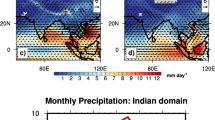Abstract
The NASA/GISS GCM is used to estimate the evaporative contributions of several oceanic regions (defined by temperature) to Antarctica's July precipitation. Tracer diagnostics in the GCM suggest that the weighted average evaporative source temperature for Antarctic precipitation as a whole is about 12°C. The average source temperature for local precipitation there varies from 9° C to 14° C. To examine the effect of evaporative source on water isotope concentration, the GCM also follows a global deuterium (HDO) tracer and deuterium tracers evaporating from each oceanic region. The results suggest that although evaporative source temperature does affect the concentrations of the individual HDO tracers, differences in evaporative source do not explain the scatter in the roughly linear relationship between condensation temperature and isotope concentration.
Similar content being viewed by others
References
Aldaz L, Deutsch S (1967) On a relationship between air temperature and oxygen isotope ratio of snow and firn in the south pole region. Earth Planet Sci Lett 3:267–274
Aristarain AJ, Jouzel J, Pourchet M (1986) Past Antarctic peninsula climate (1850–1980) deduced from an ice core isotope record. Clim Change 8:69–89
Bromwich DH (1988) Snowfall in high southern latitudes. Rev Geophys 26:149–168
Bromwich DH, Weaver CJ (1983) Latitudinal displacement from main moisture source controls δ15O of snow in coastal Antarctica. Nature 301:145–147
Dansgaard W (1964) Stable isotopes in precipitation. Tellus 16:436–468
De Angelis M, Barkov NI, Petrov VN (1987) Aerosol concentrations over the last climatic cycle (160 kyr) from an Antarctic ice core. Nature 325:318–321
Druyan LM, Koster RD (1989) Sources of Sahel precipitation for simulated drought and rainy seasons. J Climate 2:1438–1446
Friedman I, Redfield AC, Schoen B, Harris J (1964) The variation of the deuterium content of natural waters in the hydrologic cycle. Rev Geophys 2:177–224
Giovinetto M, Bentley C (1985) Surface balance in ice drainage systems of Antarctica. Antarctic J 20:6–13
Hansen J, Russell G, Rind D, Stone P, Lacis A, Lebedeff S, Ruedy R, Travis L (1983) Efficient three-dimensional global models for climate studies: Models I and II. Mon Wea Rev III:609–662
Johnsen SJ, Dansgaard W, White JWC (1989) The origin of Arctic precipitation under present and glacial conditions. Tellus 41B:452–468
Joussaume S, Sadourny R, Vignal C (1986) Origin of precipitating water in a numerical simulation of the July climate. Ocean-Air Interactions 1:43–56
Jouzel J, Russell GL, Suozzo RJ, Koster RD, White JWC, Broecker WS (1987) Simulations of the HDO and H2 18O atmospheric cycles using the NASA/GISS general circulation model: the seasonal cycle for present-day conditions. J Geophys Res 92:14739–14760
Jouzel J, Koster RD, Suozzo RJ, Russell GL, White JWC, Broecker WS (1991) Simulations of the HDO and H2 18O atmospheric cycles using the NASA/GISS general circulation model: sensitivity experiments for present day conditions J Geophys Res 96:7495–7507
Jouzel J, Merlivat L (1984) Deuterium and oxygen-18 in precipitation: modeling of the isotopic effects during snow formation. J Geophys Res 89:11749–11757
Koster R, Jouzel J, Suozzo R, Russell G, Broecker W, Rind D, Eagleson P (1986) Global sources of local precipitation as determined by the NASA/GISS GCM. Geophys Res Lett 13:121–124
Koster RD, Eagleson PS, Broecker WS (1988) Tracer water transport and subgrid precipitation variation within atmospheric general circulation models. Tech Report 317, Ralph M. Parsons Laboratory, Dept. of Civil Engineering, MIT, Cambridge, Massachusetts USA
Koster RD, Broecker WS, Jouzel J, Suozzo RJ, Russell GL, Rind D, White JWC (1989) The global geochemistry of bomb-produced tritium: general circulation model compared to available observations and traditional interpretations. J Geophys Res 94:18305–18326
Legrand MR, Lorius C, Barkov NI, Petrov VN (1988) Vostok (Antarctica) ice core: atmospheric chemistry changes over the last climatic cycle (160000 years). Atmospher Environm 22:317–331
Lorius C, Merlivat L (1977) Distribution of mean surface stable isotope values in east Antarctica: observed changes with depth in a coastal area. Isotopes and Impurities in Snow and Ice, IAHS Publ. 118: pp 127–137
Morgan VI (1982) Antarctic ice sheet surface oxygen isotope values. J Glaciol 28:315–323
Petit JR, White JWC, Young NW, Jouzel J, Korotkevich YS (1991) Deuterium excess in recent Antarctic snow. J Geophys Res 96:5113–5122
Petit JR, Briat M, Royer A (1981) Ice age aerosol content from east Antarctic ice core samples and past wind strength. Nature 293:391–394
Russell GL, Lerner JA (1981) A new finite-differencing scheme for the tracer transport equation. J Appl Meteorol 20:1483–1498
Saigne C, Legrand M (1987) Measurements of methanesulphonic acid in Antarctic ice. Nature 330:240–242
Schwerdtfeger W (1970) The climate of the Antarctic. In: Orvig S (ed) Climates of the polar regions. World Survey of Climatology 14, Elsevier, New York: 253–355
Siegenthaler U, Matter H (1983) Dependence of δ18O and SD in precipitation on climate. Paleoclimate and paleowaters: a collection of environmental isotope studies. International Atomic Energy Agency, Vienna, Austria: 37–51
Author information
Authors and Affiliations
Additional information
Offprint requests to: R Koster
Rights and permissions
About this article
Cite this article
Koster, R.D., Jouzel, J., Suozzo, R.J. et al. Origin of July Antarctic precipitation and its influence on deuterium content: a GCM analysis. Climate Dynamics 7, 195–203 (1992). https://doi.org/10.1007/BF00206861
Received:
Accepted:
Issue Date:
DOI: https://doi.org/10.1007/BF00206861




